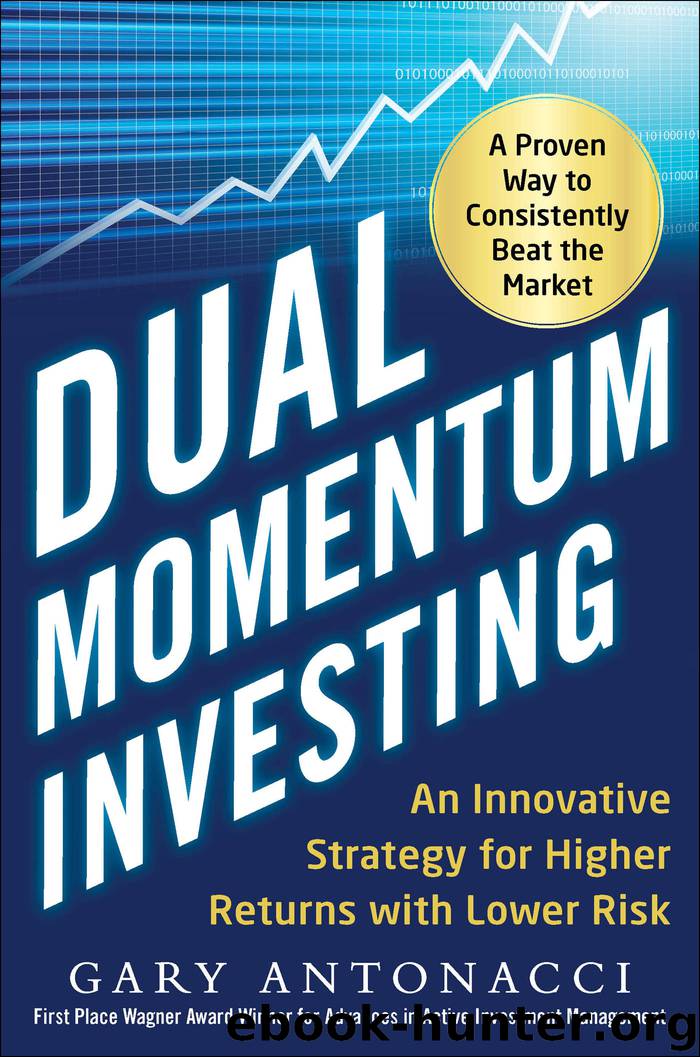Dual Momentum Investing by Gary Antonacci

Author:Gary Antonacci
Language: eng
Format: epub
Publisher: McGraw-Hill Education
Published: 2015-05-21T16:00:00+00:00
TAIL RISK AND MAXIMUM DRAWDOWN
For normal distributions, upside and downside volatility are approximately the same, but financial market returns are usually non-normally distributed. The difference between upside and downside volatility can be particularly problematic when returns are highly skewed, or nonsymmetric. Stock market returns are often negatively skewed, with an asymmetric left tail extending more toward negative values.12 This creates tail risk, which can lead to greater-than-expected losses and aggravate the animal spirits mentioned earlier. Positive skewness is much preferred, since surprises should then work in our favor.
Academic research often just ignores tail risk. However, left tail risk, indicating negative skewness, is undesirable from a practitioner point of view. It can lead to large equity erosions, emotional distress, and untimely investor withdrawals.13 What we need is an indicator of maximum adverse consequences so we can avoid strategies that have too much left tail risk.
One such indicator is conditional value-at-risk (CVaR), also known as expected shortfall. CVaR uses the actual distribution of returns to determine the expected loss of a portfolio when there is a loss. CVaR is difficult to calculate, and the results are not intuitively appealing. I find it difficult to relate to the CVaR values and prefer instead to use a visual indicator called a box plot. This shows on one comparative chart median returns, interquartile ranges of returns, and expected extreme values.
Another simple indicator of tail risk that is intuitive, easy to understand, and relatively easy to calculate is maximum drawdown.14 Drawdown is the percentage that price moves down from a new high. Since we use monthly returns, maximum drawdown to us means the maximum cumulative peak-to-valley retracement on a month-end basis.15
As with most things, there are some potential drawbacks to using maximum drawdown. First, maximum drawdown is dependent on the length of one’s performance record. All else being equal, maximum drawdown increases with track-record length. Therefore, it is most useful when maximum drawdown is used to evaluate strategies having the same amount of performance history and plenty of historical data. Second, maximum drawdown represents only a single occurrence. The number of drawdowns that occur and drawdowns other than the very worst one may also be important to us. To get a better sense of the depth, quantity, and duration of drawdowns, I look at drawdowns in different ways, at different times, and under different conditions.
Download
This site does not store any files on its server. We only index and link to content provided by other sites. Please contact the content providers to delete copyright contents if any and email us, we'll remove relevant links or contents immediately.
| Analysis & Strategy | Bonds |
| Commodities | Derivatives |
| Futures | Introduction |
| Mutual Funds | Online Trading |
| Options | Portfolio Management |
| Real Estate | Stocks |
Rich Dad Poor Dad by Robert T. Kiyosaki(6500)
Pioneering Portfolio Management by David F. Swensen(6250)
How To Win Friends and Influence People by Dale Carnegie(4466)
The Money Culture by Michael Lewis(4121)
The Dhandho Investor by Mohnish Pabrai(3719)
The Wisdom of Finance by Mihir Desai(3687)
Liar's Poker by Michael Lewis(3406)
Fooled by Randomness: The Hidden Role of Chance in Life and in the Markets by Nassim Nicholas Taleb(3076)
The ONE Thing by Gary Keller(3030)
The Intelligent Investor by Benjamin Graham Jason Zweig(3009)
Mastering Bitcoin: Programming the Open Blockchain by Andreas M. Antonopoulos(3004)
Rich Dad Poor Dad: What The Rich Teach Their Kids About Money - That The Poor And Middle Class Do Not! by Robert T. Kiyosaki(2927)
How to Day Trade for a Living: Tools, Tactics, Money Management, Discipline and Trading Psychology by Andrew Aziz(2923)
Investing For Dummies by Eric Tyson(2920)
How to Win Friends and Influence People by Dale Carnegie(2879)
The Psychology of Money by Morgan Housel(2753)
Market Wizards by Jack D. Schwager(2667)
Zero Hour by Harry S. Dent Jr. & Andrew Pancholi(2626)
How to Pay Zero Taxes, 2018 by Jeff A. Schnepper(2620)
